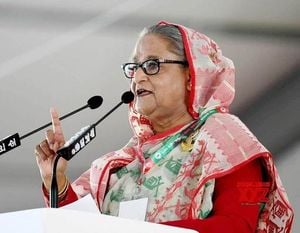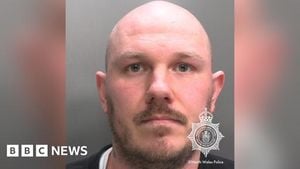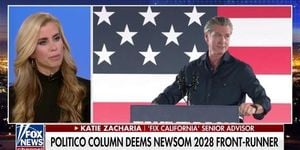In the heart of Washington, D.C., a storm of controversy erupted last week as President Donald Trump declared the nation’s capital a "crime-ridden wasteland" and ordered the deployment of 800 National Guard members to the city’s streets. The move came despite data from Washington’s Metropolitan Police showing that violent crime has actually declined since a 2023 peak—a fact that’s left many city leaders, advocates, and residents baffled and outraged.
According to National Health Ratings, the president’s intervention wasn’t limited to D.C. He also threatened similar federal actions in other Black-led cities, including Baltimore, Chicago, Los Angeles, and Oakland. The common thread among these cities? Each is led by a Black mayor, and each has recently reported significant drops in crime following the pandemic-era spike.
Yet, rather than celebrating these improvements, Trump’s administration has doubled down on a narrative of urban chaos, using it to justify what critics describe as an aggressive, boots-on-the-ground approach. Images and videos circulating online have shown federal officers targeting Black communities, with some footage capturing officers beating a Black man for recording them on his phone. As an op-ed published August 18, 2025, argued, "Injustice becomes routine when the public buys into racist stereotypes that portray Black people as inherently criminal. Such ideas open the door for over policing like this."
So, how did we get here? And why, as the essayist asked, do some ignore low crime rates in favor of policies many see as racially motivated?
Mayors across the country are pushing back. Van Johnson, mayor of Savannah, Georgia, and president of the African American Mayors Association, didn’t mince words: "It gives us an opportunity to say we need to amplify our voices to confront the rhetoric that crime is just running rampant around major U.S. cities. It’s just not true. It’s not supported by any evidence or statistics whatsoever."
Johnson and his colleagues point to the data. In Chicago, Mayor Brandon Johnson hailed the city’s "historic progress driving down homicides by more than 30% and shootings by almost 40% in the last year alone." In Los Angeles, Mayor Karen Bass noted that homicides fell 14% between 2023 and 2024, dismissing the federal intervention as a mere "power grab." Baltimore’s public safety data dashboard shows historic decreases in both homicides and nonfatal shootings in 2024, with carjackings down 20% the previous year. Oakland, for its part, reported a 21% drop in homicides and a 29% decrease in all violent crime in the first half of 2025 compared with the same period in 2024.
How did these cities achieve such progress? According to the Buffalo News, many have shifted toward community-centered, public health approaches to violence prevention. Baltimore, for example, launched its Comprehensive Violence Prevention Plan in 2021 under Mayor Brandon Scott, investing in community violence intervention, services for crime victims, and other initiatives. Oakland credits its Department of Violence Prevention and collaborations with community organizations for its gains.
Yet, despite these successes, the Trump administration has chosen to focus on high-profile incidents, such as the attack on a Department of Government Efficiency employee by two teenagers in D.C., as justification for federal intervention. Trump also pointed to issues like homeless encampments, graffiti, and potholes as evidence of urban decay—a characterization that city officials say is out of step with reality.
For many mayors, the president’s actions raise troubling questions about motive. As Savannah’s Johnson observed, "It was not lost on any member of our organization that the mayors either were Black or perceived to be Democrats. And that’s unfortunate. For mayors, we play with whoever’s on the field."
Mayor Brandon Scott of Baltimore accused Trump of exploiting crime rather than caring about curbing violence. "He has actively undermined efforts that are making a difference saving lives in cities across the country in favor of militarized policing of Black communities," Scott said via email. He pointed out that the Justice Department had slashed more than $1 million in funding for community anti-violence measures this year—a move he said runs counter to the administration’s stated aims.
Social justice advocates have also weighed in, warning that federal intervention could roll back hard-won progress. Nicole Lee, executive director of Oakland’s Urban Peace Movement, worries that a military presence "creates kind of an environment of fear in our community." She cautioned that curfews or other blanket measures would disproportionately affect young people of color and "put young people in the crosshairs of the criminal justice system."
Meanwhile, the roots of over policing and urban violence are tangled in decades of policy and infrastructure decisions. As National Health Ratings and Stacker Studio have reported, pedestrian fatalities have soared by 80% since 2009, with Black Americans killed in traffic-related crashes more than twice as often as white Americans while walking. The highway boom of the mid-20th century often routed major roads through Black neighborhoods, destroying businesses and homes and making streets more dangerous for those on foot. A 2023 UNC Chapel Hill study found that formerly redlined neighborhoods—areas where Black residents were denied mortgages and investment—are now more likely to have deadly arterial roads, a legacy of structural racism that persists today.
Despite these challenges, some cities have made strides in pedestrian safety. New York City’s Vision Zero program, launched in 2014, reduced pedestrian deaths by 45% over a decade, with Black and low-income residents seeing particular benefits. Boston and Chicago have implemented similar measures, lowering speed limits and redesigning streets to protect vulnerable road users.
But the battle over who controls city streets continues. Washington Mayor Muriel Bowser and other Black mayors are watching the federal takeover closely. On August 18, city officials filed suit to try to block the intervention. "Black mayors are resilient. We are intrinsically children of struggle," said Van Johnson. "We learn to adapt quickly, and I believe that we will and we are."
As the debate rages, one thing is clear: the facts on the ground tell a different story than the one being used to justify federal crackdowns. Crime is down, not up, in many major cities. The question remains—will those facts be enough to change the narrative?






